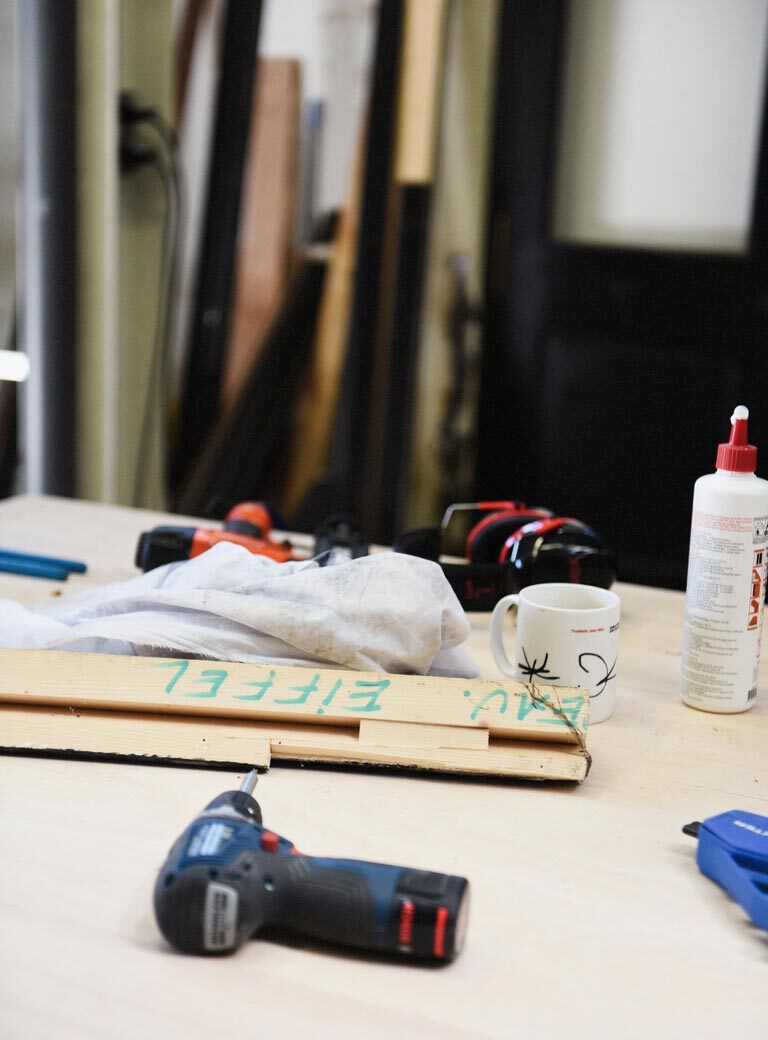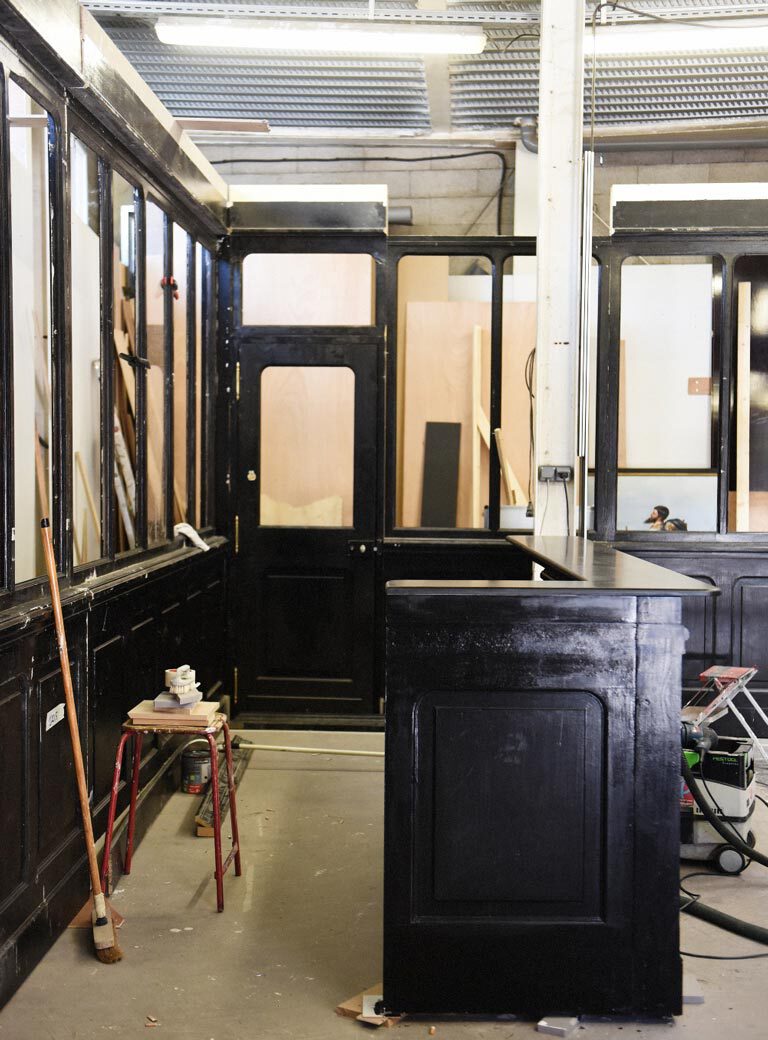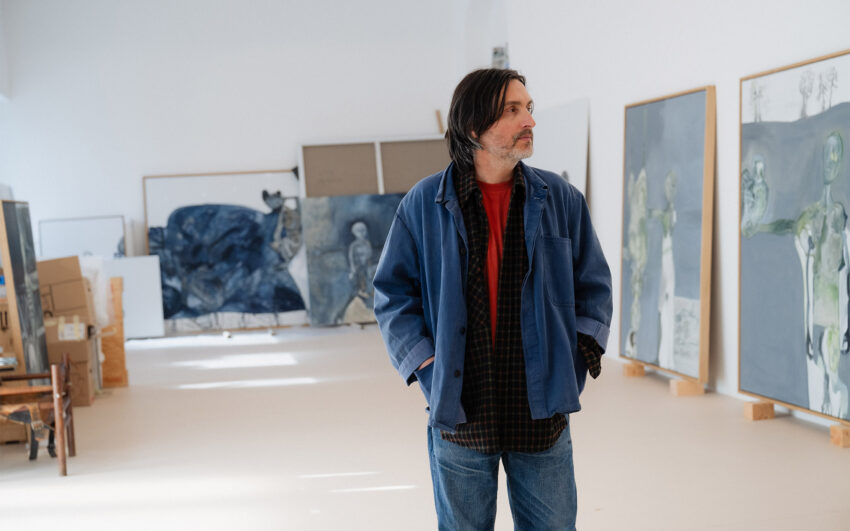With the intention of avoiding judgment, cultural cynicism, and irony, the Paris-based French-Algerian artist Neïl Beloufa creates work reflecting and representing our contemporary reality. He’s also busy with utilizing new systems and technologies such as gamification and blockchain to develop more ‘virtuous’ methods of operation in the art world, a preoccupation that has informed Pandemic Pandemonium, his current exhibition at Secession, Vienna. We spoke to Beloufa about social pressures in cultural spaces, why he doesn’t really see himself as an artist, and why he believes the pandemic is a beta version of the future.
Neïl, when and how did you first become interested in art?
In the beginning I wanted to be a graphic designer, I went to an applied arts school, but I was very bored there, and also, I wasn’t very good at it. I then applied to a fine arts school and began attending lectures there in the evening and on weekends along with my peers. It felt to me like somewhere I could experiment and try out more interesting stuff… I felt freer working in the fine arts sphere than just being instructed on how to help clients to develop websites.
During the time you were studying at both of these two schools, who or what were some of your main artistic inspirations?
I was fascinated by both film and art history. I didn’t have one particular role model, and my influences and interests changed all the time. I was consuming a lot. I guess if I was a student today, I would be consuming Tik Tok, but this was before such platforms existed. There were also very few online magazines: there was no Contemporary Art Daily or websites that brought art into the mainstream. I grew up during the 1990’s watching work by the likes of German filmmaker Harun Farocki and other creators from the France of that time. I guess I’m a child of that generation. I hate listing names though, so you won’t get that from me.
You also spent time in the U.S., completing exchanges at the California Institute of the Arts and The Cooper Union, New York. What attracted you to studying in America? Was there something about the U.S. art scene that interested you?
I was completing two different courses, so I got to do two exchanges. I guess it was kind of wrong of me to do that. For my generation, the allure of America was really strong. I really wanted to go to New York and L.A. at least once in my life because they sounded cool. I hadn’t really thought it out in much detail though, I just had this ingenuous desire to see the world. Later I felt bad because I realized I should have gone somewhere in the Global South.



What are some of the key things you remember learning during your time in America that have influenced you as an artist?
In America, people have a very pragmatic, and less romantic, relation to culture. They understand that it’s a job and that people have to struggle to survive. Unlike in Europe, American art students are in debt and not protected by the state. They don’t grow up with the myth that you can be an artist and not worry about money. If you don’t come from a wealthy family, it’s a big risk to choose to study art. Very quickly you have to develop your own economic models to survive. I’m from Algeria, a country that has a history of revolutionary, leftist people. Going to the U.S. made me understand the value and need for these anti-establishment thinkers. I think this fascination with social class struggle really changed my way of working. I became less afraid of trying things out, because art became equivalent to survival. I would think to myself: “If I don’t make something, I won’t eat.” I also got less scared of using pop culture to influence my work. Rather than feeling like I had to be self-referential to the intellectual strata, I got to the point where I felt comfortable saying: “yeah, I watch shitty movies,” or “my practice is influenced by Sylvester Stallone.”
After studying, how did you transition into working in art professionally?
At first, I worked as an assistant for various artists, who basically trained me to think creatively. I also got very lucky. One of the movies—Kempinksi (2007)—that I produced during a field trip with my class from applied art school started to get a lot of interest from the film and art industries. Various international film festivals and contemporary art museums wanted to present it. I was super young at the time. I didn’t really decide to start my career in this way, it just happened.

Now, key themes in your work include power, data collection and digital surveillance, nationalist ideologies, postcolonial understanding of the world, social conflicts between majority and minority societies, hegemony, and oppression. How did these diverse topics become a concern for you as an artist?
They didn’t become a concern for me as an artist, they became a concern for me as a human being. To be honest, I don’t really see myself as an artist: I don’t think that word is a good description of the way I work. I have no craft, I can’t make anything, and I don’t have any personal style or vision. I just have strategies and structures. I simulate constraints from the wider world and see what I can create with them using a production model that interests me. I believe that art is created from the constraints of the system it is part of. For example: I would have no desire to work in a white cube space if the white cube wasn’t paying me. The form of my work has arisen from the fact that the only way for me to survive is to display in such contexts. In reference to digital surveillance and data collection, basically I’m a really paranoid person. When Facebook was launched, I couldn’t sleep. I was living in the U.S. at the time, and I created fake humans on Facebook and wrote scripts about people controlling each other through social media. All of this stuff really scares me. I think right now we’re living in a really dystopian society. For me, it’s the purpose of artists to exist within that society, but also to take a step back from it and represent it with critical distance.
The concept of critical distance relates to the fact that you aim to renounce moral evaluation of the themes your work addresses. How do you avoid expressing your opinions and judgements about topics you’re so passionate about, and why do you think it’s important to do so?
I don’t like “civil wars”, or the vanity of small differences. There is no real difference between me and Jeff Koons, for example. We’ve sold to the same people and the same places. Even if my agenda seems very different from Koons to people within the art community, if you presented both mine and his work to people outside of the creative arena they’d see the same shit: objects on white walls created for rich people. The reality is, art doesn’t matter. It’s a symbolic fight. It’s actually useless for society in the short term, and in the long term… well I’m not sure whether society even has a long-term future. You need to be in a really strong, uncompromised position to be able to judge society. I’m not able to do that: I’ve worked for powerful people and institutions who pay me. I’m in the service of something I criticize, and I know it. That said, I think that when society is doomed, it’s better to experiment and take risks than not be able to participate. Taking part in sociological discourse doesn’t change anything, but if you make work and pay someone who wouldn’t usually get paid in the process, that can change their life.



Various artists, individuals, and organizations are using new systems and tools such as blockchain technology and NFTs in an attempt to become more autonomous and extricate themselves from the current power systems you mentioned.
That’s what I’m working on at the minute at my studio. We’ve started a decentralized company called EBB. We’re not performative, so there’s not a lot of media about us. We’re creating products, working with brands and tech companies, using blockchain, gamifying our shows, and trying to create new systems of production that we think are more virtuous than those that exist in the art world at the moment. We’re doing this because I really strongly believe that we can’t expect different artistic outcomes if we just continue to use the same broken system that we have done for years. You can’t work in the same way as an artist from the 19th century and not expect your results to be identical to theirs, which didn’t do any good for society. I believe that art from the 20th century helped to validate the ideas that are now destroying the world.
We’ve discussed a lot of heavy topics, but your work also endeavors to be humorous, right? Why do you think humor is important to art?
I think humor is important to life. Humor has been used for centuries as a cathartic and non-aggressive way of tackling complex subjects. It helps to get people on board. Building these kinds of social relationships is something that I really like. Having said that, I hate social pressure, especially that associated with visiting museums. I spent ten years of my practice feeling pressured by the environments I worked in. Now I’m getting older so I don’t care as much, but I used to go into white cubes and feel like I had to “get” things because a gallery had ordained them beautiful or powerful, even though I didn’t understand why. If people from the intellectual class who are bourgeois and have economical means are feeling this pressure, can you imagine how it would affect people who don’t have easy access to art, which is like 80% of the world? It’s horrible.


I think there’s also a social pressure to behave or act in a certain way in cultural spaces. I’m from a dance background and there’s a lot of discussions about the unspoken “codes of conduct” in theaters that can be quite exclusionary.
The last time I was at an opening, I was with a friend at this big beautiful museum. I think it was an old airport. There was an artwork placed really far away from us: a chair with a glass bottle or something. We started walking through that big empty space to the artwork and circled around the chair to give it the amount of attention that people think an art work deserves. The thing is, we knew it was a chair from 20 meters away, we didn’t need to go up to see it. I didn’t care about seeing a chair up close. I mean, I had a level of respect for the person who made it, but to be honest I’d rather have gone and got a beer. I think we really need a cultural shift in the art industry. I like to relate it to music. Music was originally something that was mastered by a small group of intellectuals, then technology came along and enabled it to be spread to the masses. In response to this, some people decided to protect and preserve classical forms of music, creating conservatoires so a select group could learn how to create and perform music in the way it’s been done for centuries. I’m not saying that this is bad, it’s a good thing. I just subscribed to culture for different reasons: for social interaction, information, society, and people. I work with people and I want to work towards people. At the moment, I feel like we all just see the same kinds of art work in different places, which is absurd. You can do an art world tour and see the same exhibitions in every country, with the same people. I feel like contemporary art’s vocabulary and subjects got fixed ten years ago and now they’re stuck.
Tell us about your exhibition, Pandemic Pandemonium, which is presently, until September 4, on show at Secession, Vienna.
The show we’re creating there will propose a different way of presenting works to a participatory audience. We’ve created a gamified ticketing system. People will get a username when they buy a ticket, and they can gain points by logging into the works, watching them, or taking part in a quiz. It’s very playful. At the end, they can buy the artworks using the points they’ve accrued. You can access the exhibition purely through the internet, but you get more points if you actually visit the physical space. Coming back to what I was saying before about social pressure, when you gamify an exhibition, everything is reversed. It’s much easier for a 16-year-old to understand and take part in the game than it is for directors of institutions. This reversal is a symbolic gesture and shows that we want to give power to a new generation.

EBB & Neïl Beloufa, Pandemic Pandemonium, exhibition view, Secession 2022, Photos: © Oliver Ottenschläger

EBB & Neïl Beloufa, Pandemic Pandemonium, exhibition view, Secession 2022, Photos: © Oliver Ottenschläger

EBB & Neïl Beloufa, Pandemic Pandemonium, exhibition view, Secession 2022, Photos: © Oliver Ottenschläger
Have you met any individuals or encountered institutions who are resistant to your new ways of working?
A lot of filmmakers, artists, and musicians of my generation believe that there is a problem with our current models in the arts and that we have to change by coming up with new methods of distribution and ways to relate with our audiences. Many people are willing to try. Secession, for example, is super nice. They want to give something new a shot. My exhibition with them is an experiment. It will probably fail, but that’s not the point. Other people don’t want to change. That’s what’s creating a current divergence of opinions and attitudes in the art world, this was expedited by COVID.
On the topic of COVID, how did the pandemic affect your practice?
I view the pandemic as a beta version of the new world. In the future, if we’re not locked down because of a pandemic, we will be because of global warming, war, or something else. We’re going to have to strive to survive and find models for these realities. During lockdown my studio decided that we wouldn’t close at all, and instead found ways to work autonomously and to develop different kinds of non-physical relationships with people. We made a project—that has fed into the physical exhibition at Secession—called Screen Talk. We asked institutions from all over the world to collaborate and to donate very small amounts of money ranging from 300 to 3,000 euros. We accrued a small budget of around 11,000 euros and produced a gamified website, a mini series, and a points system that enable you to acquire artworks certified through blockchain. This happened before NFTs became big. Economically, it was a failure, but in terms of numbers it was crazy. The day that The New York Times published an article about it, we had 30,000 people watching one video. That’s a much bigger level of engagement with my work than I’ve had before.

Earlier in this interview, you said you wouldn’t call yourself an artist. What term do you prefer to describe what you do?
Loads of artists say that they’re not really artists. Really, it’s bullshit. I am an artist, but the way I work is more like a production company. I work with ten to twenty people full time. There’s nothing romantic about it. It’s not a collective, it’s a company. Sometimes I don’t bring ideas to the table, other people do. We’re slowly trying to destroy the idea of the centralized figure of the artist. For example, the exhibition at Secession is billed as created by EBB, the company, not just Neil Beloufa. That’s the first step.
What do you enjoy doing when you’re not working?
I have no hobbies. I work. I have kids. That’s all I know.
Interview: Emily May
Photos: Elise Toïdé






